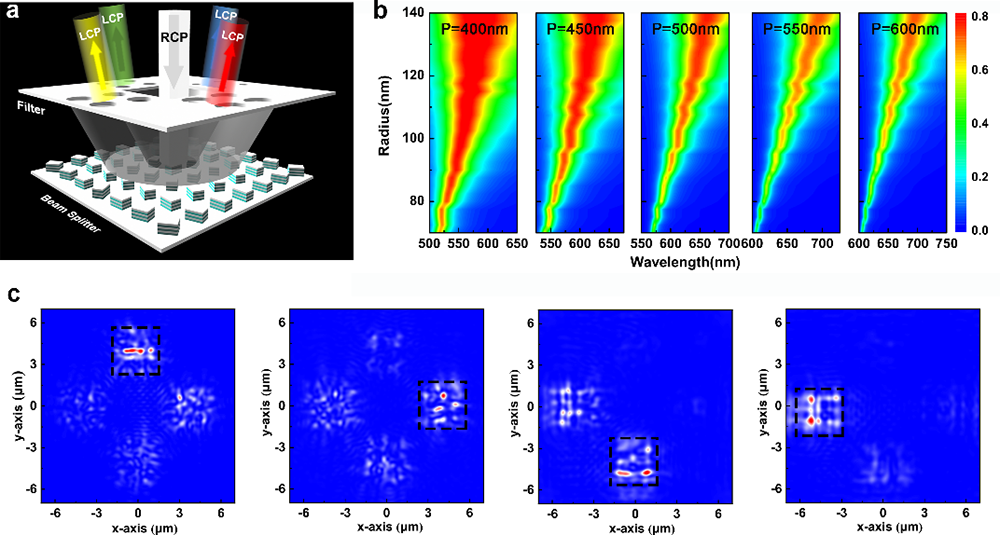Hyperbolic Metamaterial Enables Multidimensional Image and Beam Splitting in Visible Band
Date:21-02-2021 Print
Metamaterials, artificially engineered with periodic subwavelength meta-atoms, exhibit much distinct electromagnetic performance, such as negative refraction, optical cloak, and superlens, that are unavailable in naturally occurring materials. Metamaterials were usually designed and operated in microwave band. However, it's a challenge to realize the high-efficient, broadband, and multi-dimensional modulation of light in higher frequency band.
Prof. Changzhi Gu and his Ph.D. students Sha Hu and Shuo Du from N10 group, in collaboration with Prof. Li Junjie from Laboratory of Microfabrication, IOP, established the design and fabrication methods of hyperbolic metamaterials (HMMs), which are comprised of metal-dielectric multilayer. HMMs, whose iso-frequency surface is a hyperboloid, have the advantages of broadband and high refractive index in near-infrared and visible frequency band. The ZnO-Au-stacked truncated-cone-type metamaterial is proposed to realize broadband, polarization-insensitive, and wide-angle perfect absorption. This proposed multi-layer metamaterial is prepared by the combination of lithography and ion beam etching techniques. The absorption band could be experimentally tuned from near-IR to the mid-IR range by tailoring the geometric parameters. The experimental results indicate that the absorption is higher than 70% in a broadband from 2.5 μm-4.35μm (The Journal of Physical Chemistry C, 123, 13846 (2019), Cover Story).
Recently, they have made a breakthrough in the design of multidimensional optical modulation in visible band based on hyperbolic metamaterials. Through numerical simulation, they demonstrate multidimensional switchable images and 3D integrated beam splitters based on HMMs. On one hand, a switchable image controlled by output helicity and input wavelengths is achieved by arranging HMMs with different polarization conversion performance. On the other hand, polarization-multiplexed broadband beam splitter is generated by spatially engineering the subunit with broadband half-plate performance. By integrating the multiplexed beam splitter with a filter metamaterial, this multidimensional beam splitter can further realize the separation of output light by space and wavelength. This cascaded multilayer metamaterial achieves a brand-new optical functionality and offers more inspiring possibilities for the design of multifunctional optical devices in the future. The work entitled "Multidimensional Image and Beam Splitter Based on Hyperbolic Metamaterials" is recently published in Nano letters (DOI: 10.1021/acs.nanolett.0c04795) on February 11, 2021.
The work is financially supported by the MOST, NNSFC, and the CAS.
Link to the paper: https://pubs.acs.org/doi/10.1021/acs.nanolett.0c04795?fig=fig2&ref=pdf

Figure 1. Switchable image controlled by input wavelength and output polarization. (a) The schematic diagram of switching image. (b) Copolarization and cross-polarization reflectivity of four selected HMMs with different geometrical sizes at incident wavelengths of 666 and 625 nm, respectively. (c) The design of switching image at 666 nm: the left and middle patterns are the images controlled by copolarization and cross-polarization components (number "4" and "7"), respectively, and the right pattern is overlapped by "4" and "7" which determines the arrangement of multiplexed image. (d) Simulated electric field distributions for RCP-component distribution (left) and LCP-component distribution (right) at the incident wavelength of 666 nm. (e) The left pattern designed in (c) can be decoded to the middle pattern (detected by RCP analyzer) and right pattern (detected LCP analyzer) under RCP irradiation at 625 nm. (f) Simulated electric field distributions at 625 nm: RCP-component distribution (left) and LCP-component distribution (right), respectively.

Figure2. Multidimensional beam splitter based on a 3D-integrated metamaterial. (a) Schematic of the designed 3D-integrated metamaterial by vertically stacking a filter metamaterial with the broadband beam splitter. (b) The simulated transmission spectra of filter metamaterials under different periods (P) and radii. (c) The simulated electric field distributions in x-y plane for 3D integrated metamaterial under different incident wavelengths: 529, 569, 635, and 675 nm, respectively.

